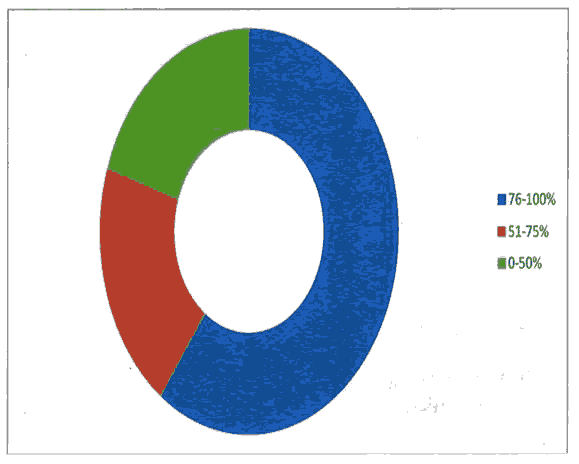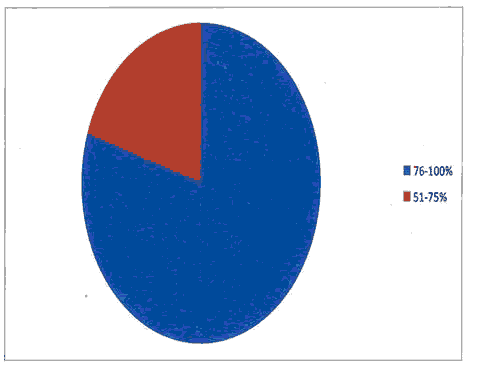Research Article - (2021) Volume 9, Issue 12
Assess the Knowledge and Practice Regarding Bio Medical Management
M.Gayathri, S.Nirmala and AR. Bharathi*
*Correspondence: AR. Bharathi, Department of Nursing, Bharath Institute of Higher Education and Research, Selaiyur, Chennai, Tamil Nadu, India, Email:
Abstract
Health and safety of the nursing staff is cardinal feature of biomedical waste management. The Medical Superintendent or head of the institute must provide training to strengthen their skills for safety. Although biomedical waste management can't be achieved without the 1 cooperation of each and every worker and patient, the nursing personnel play a significant role in this whole process. They need to be informed about current available technology to deal biomedical wastes. The sound knowledge and safe practices among all health care staff need to be strengthened. Biomedical waste management is an important issue of concern to all healthcare personnel as inappropriate management has the potential for serious infections and noninfectious injury to patients and care providers. Inadequate management of biomedical waste can be associated with risks to healthcare workers, patients, communities and their environment. The aims and objectives of the study were to assess the knowledge, attitude and practice of health care.Keywords
Biomedical waste management, Medical Superintendent, Infections and non-infectious, Health care management, Health and safetyIntroduction
All human activities produce waste. Such waste may be dangerous and needs safe disposal. Industrial waste, sewage and agricultural waste, pollute water, soil and air; it can also be dangerous to human beings and environment. Similarly, hospitals and other health care facilities generate lots of waste which can transmit infections, particularly HIV, Hepatitis B & C and Tetanus, to the people who handle it or come in contact with it.
Until fairly recently, medical waste management was not generally considered an issue. In the 1980s and 1990s, concerns about exposure to human immunodeficiency virus (HIV) and hepatitis B virus (HBV) led to questions about potential risks inherent in medical waste. Thus hospital waste generation has become a prime concern due to its multidimensional ramifications as a risk factor to the health of patients, hospital staff and extending beyond the boundaries of the medical establishment to the general population-2
Hospital waste refers to all waste, biologic or non-biologic that is discarded and not intended for further use. Medical waste is a subset of hospital waste; it refers to the material generated as a result of diagnosis, treatment or immunization or patients ana associatea oiomeaicai research. Biomedical waste (BMW) is generated in hospitals, research institutions, health care teaching institutes, clinics, laboratories, blood banks, animal houses and veterinary institutes.
Biomedical waste is the infectious waste generated from hospitals. Improper in health care management of waste generated facilities causes a direct health impact on the community, the health care workers and on the environment. The waste generated in these institutions essentially consists of solids and liquid, which may be hazardous, infectious and non-infectious. It has been estimated that up to 85% to 90% of the waste generated in hospitals is non-infectious (free with any body fluids, which is similar to domestic waste). It is the remaining 10% to 20% of waste that is of concern because it is hazardous and infectious. . In addition, waste that is unsegregated and not treated in the right manner would cause environmental pollution affecting the health of the community. From waste audits done at several hospitals by a few NGOs, arrived at some figures, which can now be used and extrapolated for the whole country. These audits must be conducted only after adequate training on waste segregation is given to health care institutions.
Health-care waste management in India is receiving greater attention due to recent regulations (the Biomedical Wastes (Management & Handling) Rules, 1998). The prevailing situation is analyzed covering
various issues like quantities and proportion of different constituents of wastes, handling, treatment and disposal methods in various healthcare units (HCUs). The waste generation rate ranges between 0.5 and 2.0 kg bed-1 day-1. It is estimated that annually about 0.33 million tons of wastes are generated in India. The solid waste from the hospitals consists of bandages, linen and other infectious waste (30- 35%), plastics (7-10%), disposable syringes (0.3-0.5%), glass (3-5%) and other general wastes including food (40-45%). In general, the wastes are collected in a mixed form, transported and disposed of along with municipal solid wastes. At many places, authorities are failing to install appropriate systems for a variety of reasons, such as non¬availability of appropriate technologies, inadequate financial resources and absence of professional training on waste management. Hazards associateci witn neaitn-care waste management ana snortcomings in tne c existing system are identified.6
The nurses spend maximum time with patients in the ward than any other member of the health team, increases their exposure and risk to the hazards present in hospital environment, mainly biomedical waste. They need to be well equipped with latest information, skills and practices in managing this waste besides reducing hospital-acquired infections to protect their own health. They are also responsible for preventing risk due to waste to the other) members of health team and community at large.
In 2006 a study conducted in medical, dental, nursing and midwifery students at the university teaching hospitals of Shiraz, Iran reported that 71.1%of the students have needle stick injuries. It has been found that one third of sharp injuries are related to disposal process. Investigator experienced that most of staff nursess had limited knowledge about bio medical waste management. So there is a need to up-to-date their knowledge and practices of bio medical waste management. So investigator felt that awareness through teaching programme is effective way for nursing students to equip themselves with latest information about skills and practices in biomedical waste management, which help them to work effectively in the hospital.
Materials and Methods
This methodology to assess the knowledge and practice regarding bio medical waste management among staff nurses. It consists of research approach, research design, settings, population, sample, sample size, sampling technique and sample selection criteria.
Table 1: Demographic data and frequency.
| Demographic Data | Frequency |
|---|---|
| 1. Age | |
| A .21-30 | 49%) |
| B. 31-40 | 0.26 |
| C .Above 40yrs | 0.25 |
| 2.Marital status | |
| A, Married | 0.45 |
| B. Unmarried | 0.55 |
| 3.Educational status | |
| A. Degree course | 0.48 |
| B. Certificate course | 0.52 |
| 4.Family income | |
| A.6000-10000 | 0.24 |
| B.10001-15000 | 0.56 |
| C. Above 15000 | 0.2 |
Research approach
Quantitative research approach was used in this study
Research design
Descriptive design was adapted for the study
Settings of the study
The study was conducted in Hindu mission hospital with comprises of 60 staff nurses.
Population
The samples consisted of staff nurses at Hindu mission hospital
Sample size
The sample size was 30 staff nurses
Sampling techniques
A non-probability purposive sampling technique was adopted to select the samples in the study. To assess the demographic characteristics such as age, religion, type of family, educational status, family income, marital status, occupation and sources of information.
Section 1: Multipule choice question to assess the knowledge on bio medical waste management
Section 2: Ture or false question to assess the practice.
Results
This chapter describe the analysis of numerical data collected by the study instruments and their meaning and relevance .
The data was collected from 30 staff nurses and analyzed according to objectives of study, the findings of the study were organized and presented under the following headings.

Figure 1: Distribution of level of knowledge regarding bio'medical waste management.
Figure 1 reveals that 60% of the nurses had adequate knowledge, 20% had moderately adequate knowledge and 20% had inadequate knowledge regarding bio medical waste management.

Figure 2: Distribution of level of practice regarding bio medical waste management.
Figure 2: reveals that 80% of the nurses had adequately practiced , 20% had inadequate practice regarding bio medical waste management.
The focus of the study was to assess the knowledge and practice regarding bio medical waste management among staff nurses at hindu mission hospital. To assess the knowledge and practice of staff nurses regarding bio medical waste management.
Conclusion
The study concluded that 60% of the nurses had adequate knowledge, 20% had moderately adequate knowledge and 20% had inadequate knowledge regarding bio medical waste management and 80% of the nurses had adequately practiced , 20% had inadequate practice regarding bio medical waste management.
Ethical Approval
The study was approved by the Institutional Ethics Committee.
Conflict of Interest
The authors declare no conflict of interest.
Acknowledgments
The encouragement and support from University, Chennai, India is gratefully acknowledged for providing the laboratory facilities to carry out the research work.
References
- Nagaraju, B, Padmavathi GV, Puranik DS, and Shantharaj MP, et al. "A study to assess the knowledge and practice on bio-medical waste management among the health care providers working in PHCs of Bagepalli Taluk with the view to prepare informational booklet." International journal of medicine and biomedical research 2, (2013): 28-35.
- Hegde, Veda, Kulkarni Raghavendra D, and Ajantha GS. "Biomedical waste management." J Oral Maxillofacial Pathology 11, (2007): 5.
- Windfeld, Elliott Steen, and Su-Ling Brooks Marianne. "Medical waste management–A review." J Environ Manag 163, (2015): 98-108.
- Jaysri, Alladi. "Hospitals wake up to waste management." The Hindu online edition, Monday, Feb02 (2004).
- Patil, AD, and Shekdar AV. "Health-care waste management in India." J Environ Manage 63, (2001): 211-220.
Author Info
M.Gayathri, S.Nirmala and AR. Bharathi*
Department of Nursing, Bharath Institute of Higher Education and Research, Selaiyur, Chennai, Tamil Nadu, IndiaCitation: M. Gayathri, S.Nirmala, AR. Bharathi Assess the Knowledge and Practice Regarding Bio Medical Management, J Res Med Dent Sci, 2021, 9(11): 1-4
Received: 01-Dec-2021 Accepted: 15-Dec-2021 Published: 22-Dec-2021
